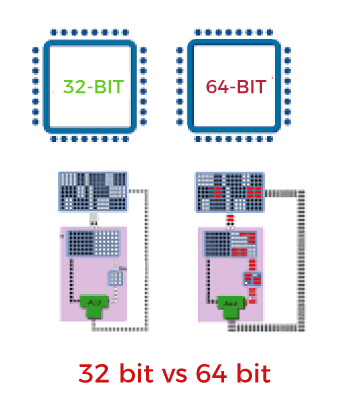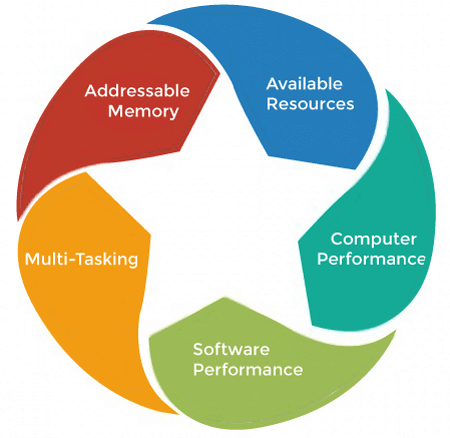Difference between 32 bit and 64 bit Operating System
In computing, a byte is the unit of data, and processing is generally denoted as bit processing. In general, there exist two types of processors, namely a 32-bit processor and a 64-bit processor. This type of processor tells us how much memory a processor can have access from a CPU register.

- A 32-bit system can access 232 memory addresses, i.e., 4 GB of RAM or physical memory; ideally, it can also access more than 4 GB of RAM.
- A 64-bit system can access 264 memory addresses, i.e., actually 18-Quintillion bytes of RAM. In short, any amount of memory greater than 4 GB can be easily handled by it.
With an increase in the availability of 64-bit processors and larger RAM capacities, Microsoft and Apple both have upgraded versions of their operating systems designed to take full advantage of the new technology. The first fully 64-bit operating system was Mac OS X Snow Leopard in 2009. Meanwhile, the first Smartphone with a 64-bit chip (Apple A7) was the iPhone 5s.
What is 32-Bit Operating System?
It is a CPU architecture type that holds the capacity to transfer 32 bits of data. It refers to the amount of data and information that your CPU can easily process when operating. A majority of the computers produced in the early 2000s and 1990s were 32-bit machines.
One bit in the register can typically reference an individual byte. Thus, the 32-bit system is capable of addressing about 4,294,967,296 bytes (4 GB) of RAM. Its actual limit is less than 3.5 GB (usually) because a portion of the register stores various other temporary values apart from the memory addresses.
What is 64-Bit Operating System?
The 64-bit microprocessor allows computer systems to process information, data, and memory addresses represented by 64 bits. Such a system can typically reference 16 exabytes (17,179,869,184 GB), or 18,446,744,073,709,551,616 bytes of memory.
A 64-bit system (a computer with a 64-bit processor) can access more than 4 GB of RAM. It is numerous million times more than what an average workstation would require to access. It means that if a computer has 8 GB of RAM, it requires a 64-bit processor. Or else, the CPU will be inaccessible to at least 4 GB of the memory.
Advantages of 64-bit over the 32-bit operating system
Below are the following advantages of a 64-bit operating system over the 32-bit operating system, such as:

- Addressable memory: 32-bit operating systems can address a maximum of 4 GB of RAM. But 64-bit operating system can address up to 17,179,869,184 GB (16 exabytes). That’s a lot more than 4GB of memory that a 32-bit operating system can handle.
- Available Resources: The 64-bit operating system can make full use of available system resources compared to a 32-bit system. To simplify, installing more RAM on a system with a 32-bit OS doesn’t impact performance. However, upgrade that system with excess RAM to the 64-bit version of Windows, and you’ll notice a difference.
- Computer Performance: The system can perform more calculations per second using a 64-bit system with a 64-bit processer. As a result, it increases the processing power and makes a computer run faster. This is limited in the case of 32-bit operating systems.
- Software performance: More software’s are written to leverage the benefit of a 64-bit operating system fully. If you are using a 64-bit operating system and install software of 64 bit, you can up-front notice the increase in performance. It becomes even more critical when performing a huge operation that requires the system to access more memory. An increase in software performance leads results in an increase in overall efficiency.
- Multitasking: Using 64-bit, users can do various things in multitasking at the same time. Users can easily switch between various applications without any windows hanging problems.
Difference between 32-bit and 64-bit OS
A 64-bit processor is more capable than a 32-bit processor because it can handle more data at once. A 64-bit processor can store more computational values, including memory addresses, which means it can access over 4 billion times the physical memory of a 32-bit processor.
Here is the key difference, 32-bit processors are perfectly capable of handling a limited amount of RAM (in Windows, 4GB or less), and 64-bit processors can utilize much more. A major difference between 32-bit processors and 64-bit processors is the number of calculations per second they can perform, which affects the speed at which they can complete tasks. Below are some more differences between 32-bit and 64-bit operating systems, such as:
| Parameters | 32-bit Processors | 64-bit Processors |
|---|---|---|
| Handling of Data and Storage | As its name suggests, the 32 bit OS can store and handle lesser data than the 64 bit OS. More specifically, it addresses a maximum of 4,294,967,296 bytes (4 GB) of RAM. | The 64 bit OS, on the other hand, can handle more data than the 32 bit OS. It means that it can address a total of 264 memory addresses, which is 18-Quintillion GB of RAM. |
